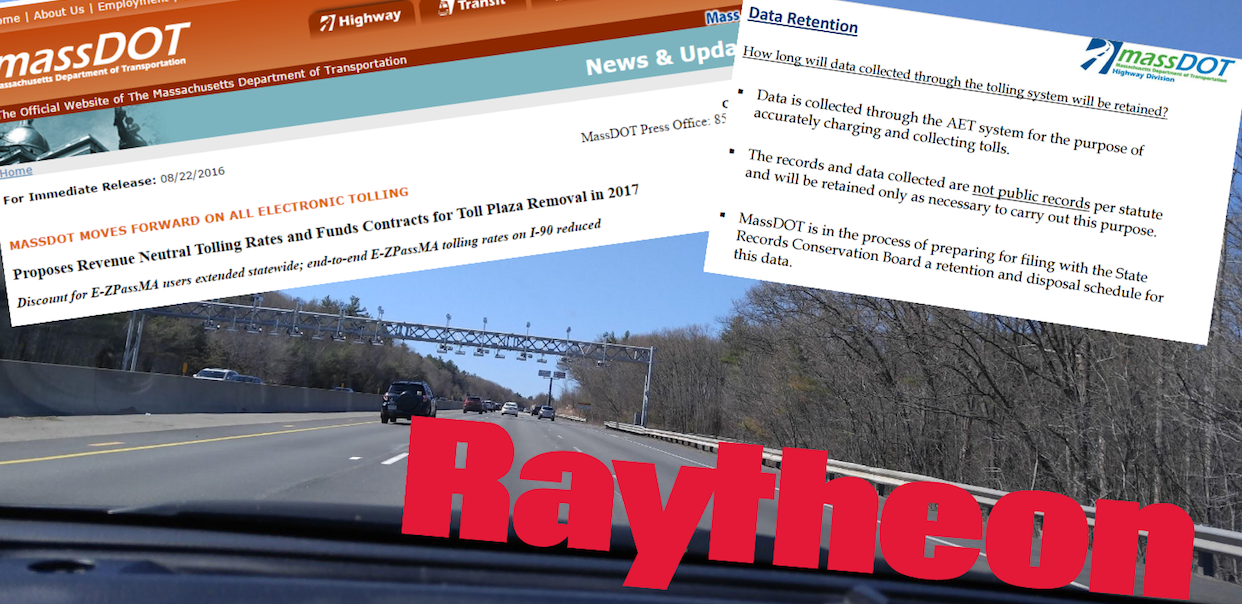Everything you think you know about the new Mass tolls is wrong
Surprise! The new all-electronic tolling system (AETS) that went live in Massachusetts on Oct 28 collects a lot more data on vehicles passing beneath pay road gantries than has been previously reported. While the focus of the media and citizens alike has centered on concerns about the system tracking vehicle speed and its retention of plate information, documents from MassDOT obtained by this reporter shed light on the truly massive amount of data that is now being culled on each vehicle cruising down the interstate.
Considering stories published in the Boston Globe and elsewhere, one might be forgiven for thinking that Raytheon’s $130 million contract with Mass produced a system that works like this: A car drives under a gantry and, depending on whether said vehicle has E-ZPass and on which gantry the car passes through, either has its license plate photographed or its transponder read.
Such assumptions would be wrong. In reality the system is far more complex, but in brief it works thusly:
- The Digital Video Audit System (DVAS) captures video of your vehicle as it approaches, passes under, and exits the gantry…
- Then your vehicle’s class and speed are determined by laser sensors which gather a read of your vehicle’s profile and its number of axles…
- Then so-called “loop detectors” beneath the asphalt verify the data collected by the lasers, while transponder readers mounted on the gantry search for your vehicle’s E-ZPass unit…
- At which point another camera, taking speed into account, captures a photo of the front and rear of your vehicle — E-ZPass transponder or otherwise — for the purpose of not only Automated License Plate Recognition (ALPR), but also to extract features unique to your vehicle in order to generate what’s called a digital “fingerprint”…
- Finally, all data from each toll gantry is aggregated to calculate the amount to be charged to your Pay by Plate or E-ZPass account. All steps of each transaction can be observed in real time by authorized personnel.
The estimated cost for this project, as specified by MassDOT in its request for proposal, was $111 million — but the contract bumped that number up to $130 million. In the end, MassDOT paid extra for Raytheon’s “innovative technical approach” which, according to the company’s Technical Proposal, “translates to maximized toll revenue.” The multinational defense contractor and industrial corporation is, after all, the inventor of automated tolling.
In this case, the company’s high-definition DVAS continuously films the road in order to capture a vehicle’s entire trip beneath a gantry. The apparatus is capable of storing a “minimum of 180 calendar days[’]” worth of video per toll zone. On top of that, as per requirements specified by MassDOT, the “system shall provide a means of automatically archiving DVAS video footage which exceeds 180 calendar days,” and “a means of restoring archived DVAS footage on a temporary basis for research purposes.”
While MassDOT’s Privacy and Data Retention slides state that “data will not be retained by MassDOT longer than necessary for toll collection” — which apparently translates to seven years for Pay by Plate customers and three months for E-ZPass users — the requirement for the archive and restore capability extends to all data collected by the AETS. In other words, it never actually deletes your data.
In another function, Vehicle Detection and Classification correlates data collected by laser scanners performing Automated Vehicle Classification (AVC) with information obtained by “loop detectors” that are installed in the pavement to sense position — all with the expressed goal of identifying vehicles for tolling purposes. One major reason for the emphasis (which some critics, myself included, believe is “overkill”) is to catch toll dodgers. According to official documents, “The system shall utilize its AVC sensors to validate that any discount plan restricted to passenger vehicles (e.g., motorcycle, automobile, pickup, minivan, SUV, passenger van, etc.) is not being used on a truck (Discount Plan Validation).”
Meanwhile, E-ZPass tag readers search for signals from transponders. Should you have one and it is detected, you will indeed pay less than a Pay by Plate customer — but you’re not exempt from having your plate captured anyway. Here’s how that works:
- A high-definition camera takes a photo of your vehicle’s “Region of Interest” — an area encompassing the license and surrounding space — for the purpose of capturing your plate and any uniquely identifying features found near your bumper. This may include, but is not limited to, your expired Feel the Bern sticker, that ghastly “Who Rescued Who?” magnet, and any marks or dents left from fender benders.
- The ALPR system also uses a process known as Optical Character Recognition to translate your license plate image into text.
- This “fingerprinting” function ultimately uses an algorithm to attach the aforementioned bumper stickers, dents, etc. with your unique plate to create a unique string of characters — a “handle” — that can be used to identify your vehicle. If the image captured by the camera is of insufficient quality, a “Fingerprint Matcher” takes the generated handle and compares it to similar handles to determine if a matching fingerprint exists. According to MassDOT’s technical provisions, which require the fingerprinting capability, these “values can then be compared against a database of previously encountered and coded (‘truthed’) vehicles for identification.”
Put more simply, just scanning your license plate apparently isn’t enough — Raytheon’s AETS photographs your vehicle’s bumpers in order to best identify the parties driving down the highway. For what purpose? Seemingly to correlate as much data as possible to prevent a need for human reviewers to verify the accuracy of ALPR reads.
For a proverbial cherry on top, MassDOT’s Trip Building feature combines all of the abovementioned data for each gantry. At which time the system uses the data to determine how many — and which — toll gantries you passed through and calculates your toll accordingly. Apparently, the amount paid may not only depend on which gantries you pass through, but on which day of the week and time of day you’re traveling. Holidays, for one, may be more expensive thanks to these thoroughly modern conveniences.
When that initial collection is through, the AETS looks to an ever-changing Hot List — a database of “wanted” plates that can hold millions of license numbers at a time. The MassDOT contract, for example, includes modules that allow preselected personnel to be sent a notification should a license plate on the list be scanned by the ALPR system. Violent criminals on the run aren’t the only ones who should be scared. So should low-level scofflaws. The department is so determined to collect as much toll revenue as possible that they’re even equipped for Raytheon’s proposed HOV status detector, which will enable state police to ping an adjacent car’s transponder to determine if they are illegitimately claiming to be traveling with more than one individual in the vehicle, which affords a discounted toll under the new system. Raytheon hopes to one day add Automated Vehicle Occupancy Detection to its system to streamline the process of catching free riders, too.
As you sit in traffic on the Mass Pike over the next month, take some time to think and compare the massive, complex system described herein to the bill of goods that drivers have been sold.
MassDOT did not respond to requests for comment.
This article was produced by the Boston Institute for Nonprofit Journalism and published in DigBoston.
Thanks for reading and please consider this:
BINJ not only produces longform investigative stories that it syndicates for free to community news outlets around Massachusetts but also works with dozens of emerging journalists each year to help them learn their trade while providing quality reporting to the public at large.
Now in its 10th year, BINJ has produced hundreds of hard-hitting news articles—many of which have taken critical looks at corporations, government, and major nonprofits, shedding light where it’s needed most.
BINJ punches far above its weight on an undersized budget—managing to remain a player in local news through difficult times for journalism even as it continues to provide leadership at the regional and national levels of the nonprofit news industry.
With your help BINJ can grow to become a more stable operation for the long term and continue to provide Bay State residents more quality journalism for years to come.
Thanks for reading and please consider this:
BINJ not only produces longform investigative stories that it syndicates for free to community news outlets around Massachusetts but also works with dozens of emerging journalists each year to help them learn their trade while providing quality reporting to the public at large.
Now in its 10th year, BINJ has produced hundreds of hard-hitting news articles—many of which have taken critical looks at corporations, government, and major nonprofits, shedding light where it’s needed most.
BINJ punches far above its weight on an undersized budget—managing to remain a player in local news through difficult times for journalism even as it continues to provide leadership at the regional and national levels of the nonprofit news industry.
With your help BINJ can grow to become a more stable operation for the long term and continue to provide Bay State residents more quality journalism for years to come.










